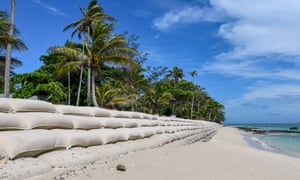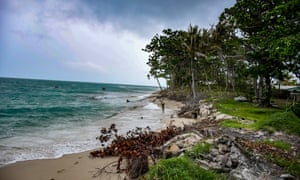An entire way of life is under threat in the Torres Strait, where locals have taken their case to the United Nations
Kabay Tamu slows his dusty white ute to walking speed on the dirt road that runs along the south-western shoreline of Warraber, a tiny coral cay in the Torres Strait that is home to about 250 people.
“This was the best spot for a day out,” 28-year-old Tamu says, recalling his childhood.
Most of the beach where Tamu used to play is gone, along with several enormous wongai trees that were a barrier of sorts, protecting the dirt road and the nearby dam, which supplies the island’s drinking water, from the sea.
Warraber is just 1.4km long, and half as wide, but shrinking fast. Some data suggests that sea levels in the Torres Strait could be rising at twice the global rate.
“This was the best spot for a day out,” 28-year-old Tamu says, recalling his childhood.
Most of the beach where Tamu used to play is gone, along with several enormous wongai trees that were a barrier of sorts, protecting the dirt road and the nearby dam, which supplies the island’s drinking water, from the sea.
Warraber is just 1.4km long, and half as wide, but shrinking fast. Some data suggests that sea levels in the Torres Strait could be rising at twice the global rate.
Now, Islanders dump their green waste to hold back the rising sea. The Intergovernmental Panel on Climate Change (IPCC) estimates that by 2100 tides will rise 30–60cm with immediate cuts to carbon emissions, and 61-110cm without.

“Being removed, forcibly removed, from here, just because of rising sea levels and the effect of climate change, and becoming climate change refugees, it’s just something that really haunts my mind,” Tamu says.

“It’s our right to be here, to have a voice, to be recognised, and to make others realise this is our home … we have the right to live a healthy life, here, on our island.”
The Billy family also live on nearby Poruma island, where Danny spent part of his childhood. Just a 15-minute flight away, Poruma is smaller and thinner. On the western shore, a road and buildings are threatened, and 250 coconut trees – a source of food, shelter and leaves used in traditional ceremonies – have already been washed away.
Local man Phillemon Mosby feels that loss keenly. The picturesque plantation should be a place to share with children and grandchildren, who would ordinarily take over the nurturing of the site.
“That experience was taken away because of climate change, because of the rising sea levels. We’ve seen areas where we used to go fishing that are no longer there. We’ve seen rocks where people used to go diving that are covered.”

“We can’t leave our community and go live down south. The living system … is totally not the way we live up here.”
Tamu, Billy, and Uncle Frank’s cousin, Nazareth Fauid, are among the eight Torres Strait Islanders who lodged a complaint last May with the United Nations human rights committee against the Australian government, alleging that its failure to reduce emissions, or pursue proper adaptation measures across the region impedes their human rights, to culture and life.
Sophie Marjanac, a lawyer with environmental non-profit ClientEarth, is representing the group, who want the government to meet its targets under the Paris Agreement, to reach net zero emissions by 2050 and to phase out thermal coal.

In early 2018, emergency funding of $650,000 was granted to Poruma to protect its western shore, but the wall was built using geotextile sandbags with a 50-year life expectancy, rather than the rock or brick asked for by the community. More work is required to protect the shoreline. Where the coast remains exposed, coconut trees lie on the beach, their roots slowly ripping away from the island.
Other islands including Boigu, Masig, and Iama need new seawalls. It is unclear which islands will be prioritised, and if the new funding will cover them all.
Tamu is quick to point out that “sea walls are only to buy us time” – the best fix is emissions reduction.
“The thing that got me was [the federal government] didn’t announce [the new funding] as seawalls to combat climate change. They said it was ‘an infrastructure development in the community’. They’re still trying to cover up climate change and the rising sea levels here.”
Tamu gained international headlines when he asked prime minister Scott Morrison to visit Warraber during the UN climate summit in New York last September. He maintains that the damage visible on Warraber and other islands would shock them into action on climate and coal.

The invitation was rejected via email in November, and Tamu says that the government is still “hearing, but not listening” when it comes to nationwide pleas for climate action.
“We really want them to lead the way. If we change and go to more renewables and hit all the targets, it won’t change the world, it won’t change everything. But it will [mean] we’re leading the way and showing all the other countries that there’s another way to be.”
While the UN complaint won’t be settled until 2021, Danny Billy says islanders won’t stop making noise until Australia finally offers global leadership on climate change
“We won’t stop until justice is served.”
- Travel and research was supported by funding from the Melbourne Press Club’s Michael Gordon Fellowship program.
- This story is co-published with The Citizen, a publication of the Centre for Advancing Journalism.

No comments:
Post a Comment